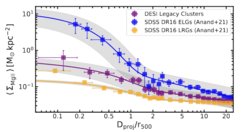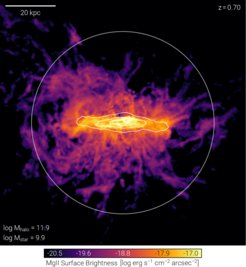Cool circumgalactic gas in galaxy clusters
Galaxy clusters are our universe's largest gravitationally bound systems, extending out to several million light-years and hosting up to 1000 galaxies. The matter permeating the clusters is known as the “intracluster medium” (ICM), a very hot and ionized gas (T~ 10-100 million K) emitting bright X-rays due to thermal bremsstrahlung. Scientists from MPA and the University of Heidelberg have discovered that the ICM also contains a significant amount of cool gas (10,000 K) up to large distances. The statistical connection between the haloes of cluster galaxies and absorption features points toward a complex origin of this cool gas where clouds are either associated with satellite galaxies or were previously stripped from their haloes.
Galaxies and the hot plasma around them (ICM) account for less than ~10 per cent of the total mass in galaxy clusters; dark matter makes up the other 90 per cent. Though astronomers have studied the hot ICM extensively with X-ray telescopes in space, such as Chandra and XMM-Newton, detailed studies of cool gas (T~10,000 K) are lacking as there are only few optically identified clusters. Quasar absorption lines at optical wavelengths are a powerful tool to study cool gas, where absorbers in intervening galaxy clusters leave traces in the spectra of a bright background source such as a quasar (see MPA Highlight of July 2021, Figure 1).

One of the most easily detectable absorbers in background quasars is singly-ionized magnesium (MgII), which exhibits a doublet profile, i.e. two absorption lines close together (with 2796 and 2803 Angstrom). Given the low ionization potential of magnesium, it traces cool gas (T ~ 10,000 K) in the circumgalactic (CGM) or intergalactic medium. Though the rest-frame wavelengths fall into the ultra-violet (UV) range, the lines shift to optical wavelengths at redshift z>0.4 and can be detected with ground-based telescopes. Previously, scientists at MPA constructed the most extensive absorber catalogue based on quasars detected in the Sloan Digital Sky Survey (SDSS) using a novel automated algorithm (see MPA Highlight of July 2021), which has allowed us to explore the nature of cool gas around galaxies in an unprecedented way.
The scientists now expanded this study to galaxy clusters, combining the latest absorber catalogue from the SDSS Data Release (DR16) and the Dark Energy Survey Instrument (DESI) legacy surveys cluster catalogue. The MgII-galaxy cluster cross-correlation from these large datasets provide us with an unprecedented opportunity to understand and constrain the nature of the cool gas in ICM. Furthermore, comparing our results with the studies explicitly performed for individual galaxies allows us to understand how the environment affects the nature of the cool gas round galaxies. We find a significant covering fraction relative to random sightlines, with the total Mg II mass within a cluster halo (estimated using surface mass density) being ~ ten times higher than for SDSS luminous red galaxies (see Figure 1). Our analysis also revealed that the covering fraction of cool gas in clusters decreases with increasing mass of the central galaxy.

Are the MgII absorbers detected in clusters associated with the CGM of its member galaxies? To investigate this question, we cross-correlated MgII absorption with cluster member galaxies from DESI and indeed found a statistically significant connection. Our analysis shows that the median projected distance between MgII absorbers and the nearest cluster member is ~200 kpc, compared to ~500 kpc in random mock samples with the same galaxy density profiles. However, we do not find a correlation between MgII strength and the star formation rate of the closest cluster neighbour. Combining our results with results from field galaxies suggests that cool gas in clusters, as traced by Mg II absorption, is: (i) associated with satellite galaxies, (ii) dominated by cold gas clouds in the intracluster medium, rather than by the interstellar medium of galaxies, and (iii) may originate in part from gas stripped from these cluster satellites in the past.
However, given the uncertainties in determining cluster membership for individual galaxies (with photometric redshifts), it is difficult to constrain the relative motion of absorbers and galaxies with our analysis. In the future, the upcoming cluster and active galactic nuclei (AGN) data from eROSITA and spectroscopic data of galaxies from DESI would allow us to perform a robust kinematic study of absorbers and cluster galaxies in more detail. This would put strong constraints on the motion of cool gas in cluster environments. Combining optical studies with the X-ray observations for clusters can also provide strong conditions on the nature of hot and cool gas in ICM.
On the other hand, one critical task would be comparing observational results such as ours with CGM simulations such as TNG50. Figure 2 (taken from Nelson et al. 2021) shows the MgII emission map around a galaxy and how it could be observed with a MUSE-like facility. These results are critical in constraining the physical models of ICM or CGM. An analysis such as ours or high resolution spectra observed with Keck like facility could provide the absorption clouds' size and mass, a key constraint that could then be compared with the theoretical models predicting the formation mechanism of cool gas clouds in such dense environments.













